Contents
- 12 amazing health benefits of mint
- 1. Relieves Pain and Indigestion
- 2. Relieves headaches and migraines
- 3. Freshens breath
- 4. Facilitates nasal breathing
- 5. Removes the feeling of fatigue
- 6. Relieves menstrual pain
- 7. Natural antibiotic
- 8. Normalizes sleep
- 9. Helps in weight loss
- 10. Relieves allergies
- 11. Improves your concentration and memory
- 12. It’s the perfect drink
- Medicinal properties of mint for women
- Types of mint, with photos and names
- What diseases are mint used for?
- Recipes for the use of mint in folk medicine
- How to make peppermint tincture?
- Mint for weight loss
- How to brew mint?
- Recipes for making desserts and lemonades with mint
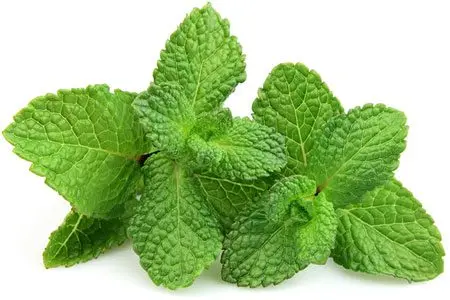
Today, about three hundred species of mint are known to man, but only about 20–25 species of this plant are widely used. But in folk medicine, peppermint is mainly used. The main difference between mint and other types of plants is, of course, its aroma. However, the aroma of peppermint is much stronger than that of its relatives.
Peppermint is a perennial herb from the mint family. The stem of peppermint is tetrahedral, hollow, about one meter high. The leaves are ovate, elongated, with teeth along the edges, and the root is horizontal and woody. Flowering of this plant begins in June and lasts until September.
Most of all, the stem and leaves are valued in peppermint, which must be collected before flowering, since it is at this time that the plant has the most essential oil – menthol. In the chemical composition of mint, the main element is menthol. About 2,5% of menthol is contained in the leaves, in inflorescences its amount reaches 4-6%.
12 amazing health benefits of mint
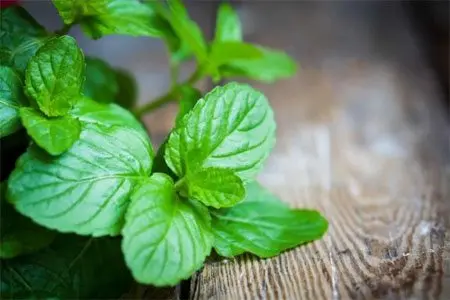
Mint leaves have undeniable health benefits. On this occasion, several studies have been conducted that confirmed the assumptions of scientists. Mint improves digestion, freshens breath, improves concentration. It acts as an antibiotic, helps reduce allergy symptoms, cope with headaches, clear the sinuses. Peppermint tea does not contain caffeine, so you can take it at any time of the day.
The composition of peppermint leaves includes essential oils: menthol, menthone and limonene. It is menthol that gives mint its characteristic aroma, familiar to everyone. Also, this substance is responsible for the cooling properties of mint.
Many people drink mint tea because of its pleasant taste and smell, but not everyone knows that it has health benefits. There are at least 12 of these properties, and they are all proven by science.
1. Relieves Pain and Indigestion
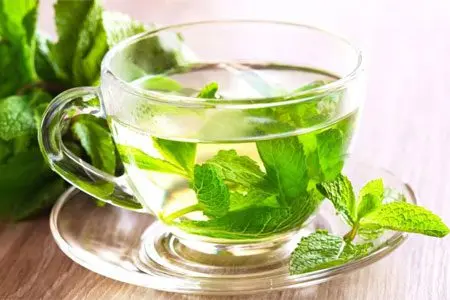
Consumption of peppermint helps to get rid of excess gas, reduce bloating. Animal studies suggest that the substances contained in the plant help to relax the muscles of the digestive system, thereby relieving pain. The smooth muscles of the intestine stop actively contracting, so that spasms become less pronounced.
A review of 9 studies concludes that mint may improve irritable bowel syndrome. In general, 926 people suffering from IBS took part in the experiments. They all took peppermint for 14 days. [1].
Another study involved 72 IBS patients who took peppermint capsules. After 4 weeks, the severity of symptoms of the disease decreased by 40% compared with people who received placebo (in the control group, this figure was 24,3%) [2].
At least 14 clinical trials have been conducted with 2000 children. It was found that in them peppermint also helps to relieve abdominal pain. [3].
Peppermint oil capsules can be taken by people undergoing chemotherapy for cancer, as they help reduce the intensity of symptoms such as nausea and vomiting. This was established during a study involving 200 people. [4]
Pure mint tea was not used for experiments, but it can be assumed that it has the same effect on the body as peppermint oil, that is, it relaxes the muscles of the digestive system.
2. Relieves headaches and migraines
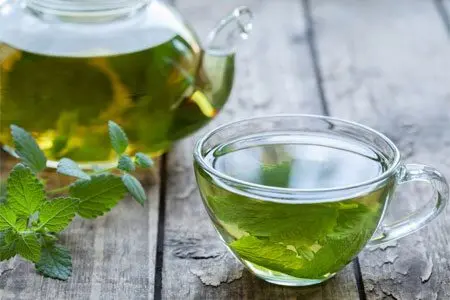
There is evidence that mint helps reduce headaches. It contains menthol, which increases blood flow, and also gives a feeling of coolness. Scientists suggest that the pain becomes less pronounced due to this effect.
It has been found that when peppermint oil is applied to the temples and forehead, the headache recedes. The effect develops after 2 hours. The study involved 35 people. As a result, the hypothesis of scientists was confirmed [5].
In another study of 41 headache patients, peppermint oil applied to the forehead was found to have the same effect as 1000 mg of acetaminophen. [6].
No such studies have been conducted on mint tea, but it is speculated that inhaling its aroma can make headaches less intense.
3. Freshens breath
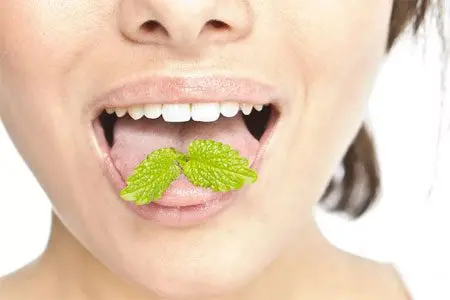
It is not for nothing that peppermint is used as a flavoring in toothpastes, mouthwashes and chewing gums. In addition to a pleasant aroma, it has an antibacterial effect, contributing to the destruction of microbes that multiply in plaque. As a result, breath becomes fresher.
In a study involving patients undergoing spinal surgery, mint with tea tree oil and lemon was used as a mouth rinse. All patients noted that their bad breath became less pronounced. [7].
Another experiment was conducted with the participation of schoolgirls. All of them noted an improvement in breathing after a week of regular rinsing of the mouth with mint infusion. [8].
Mint prevents the growth of microbes in the mouth, thereby freshening breath. There is an assumption that mint tea has a similar effect.
4. Facilitates nasal breathing
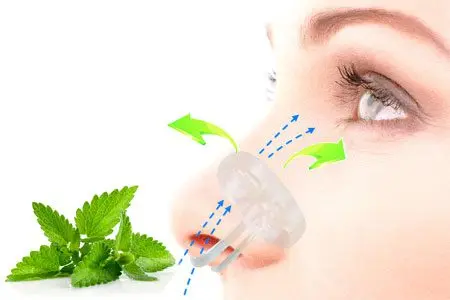
Mint has antibacterial, antiviral and anti-inflammatory effects. Therefore, tea based on this plant can be used to combat the common cold with SARS, colds and sinusitis. [9].
Menthol, which is part of peppermint, improves the perception of air flow in the nasal cavity. Therefore, inhaling the vapors of mint tea makes it easier to breathe in case of sinus congestion.
There is evidence that peppermint tea, along with chicken broth and other warm liquids taken by mouth, relieves nasal congestion.
5. Removes the feeling of fatigue

Fatigue during the daytime negatively affects performance in general. Peppermint tea energizes, helps to overcome the phenomena of asthenia more easily.
There is an assumption that the compounds that make up peppermint have a beneficial effect on the energy potential of the body. In a study of 24 healthy young adults, they were found to be less tired on cognitive tests when they received capsules containing peppermint [10].
It has also been experimentally found that inhaling mint aromas can overcome daytime sleepiness.
6. Relieves menstrual pain
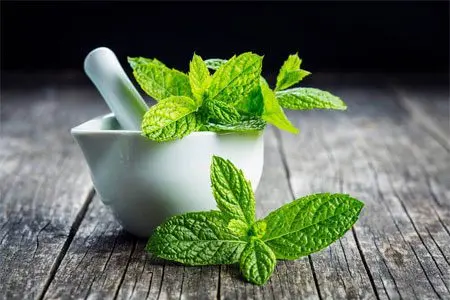
Peppermint has been proven to have the ability to relax muscles, so it’s no surprise that it helps reduce the intensity of painful menstrual cramps.
In an experiment involving 127 women, peppermint extract, taken orally, was found to have the same effect as NSAIDs. There is no difference in the strength and duration of the analgesic effect. Therefore, it is possible that mint tea can be taken to relieve pain during menstruation. [11].
7. Natural antibiotic
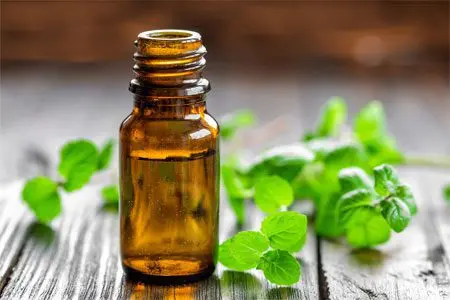
Peppermint oil has been scientifically found to have an antibacterial effect. There is evidence that it is active against E. coli, Listeria, Salmonella [12].
In addition, peppermint oil has been proven to be detrimental to staphylococci and microbes that cause pneumonia. [13].
Another antibacterial effect of peppermint is the destruction of the microbial flora that lives in the oral cavity.
Research confirms that peppermint is effective in killing bacteria that cause food poisoning and other infectious diseases. [14].
8. Normalizes sleep
Peppermint tea is the perfect bedtime drink as it does not contain the mind-boggling caffeine. In addition, mint acts as a muscle relaxant, helping to relax the body.
In one experiment, peppermint oil was found to prolong the sleep of mice that had previously been given sedatives. At the same time, menthol does not have a sedative effect on the body. [15], [16].
9. Helps in weight loss
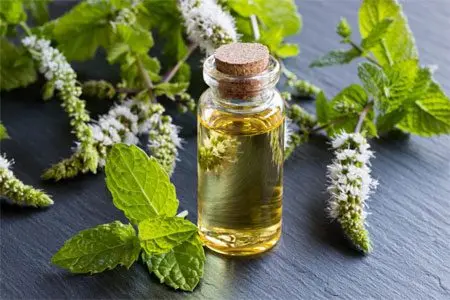
Anyone who wants to lose weight can replace regular tea with mint. It has zero calories and has a pleasant sweet taste.
In one study of 13 people, peppermint oil capsules were found to suppress appetite. [17].
Although there are other data obtained during the experiment on mice. On the contrary, it was found that rodents receiving mint extract gained body weight compared to the control group. [18].
Peppermint tea helps to reduce appetite, which means to stop overeating. However, research regarding its use for weight loss is lacking.
10. Relieves allergies
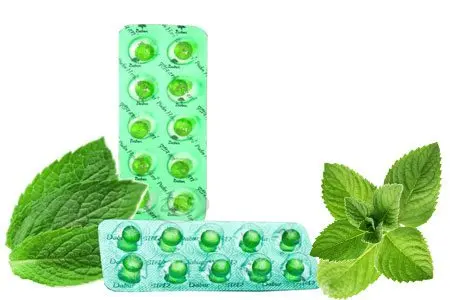
The chemical formula of peppermint includes rosmarinic acid, which can reduce allergy symptoms: itchy eyes, runny nose and even asthmatic cough. [19], [20].
In a study lasting 3 weeks, 29 people suffering from hay fever took part. All of them received a food supplement containing rosmarinic acid. As a result, they have reduced all allergy symptoms. [21].
It is not known for certain whether the amount of rosmarinic acid contained in mint is enough to treat allergies, but there is evidence that it can alleviate the course of the disease. In particular, this applies to symptoms such as sneezing, runny nose and itching. [22].
11. Improves your concentration and memory
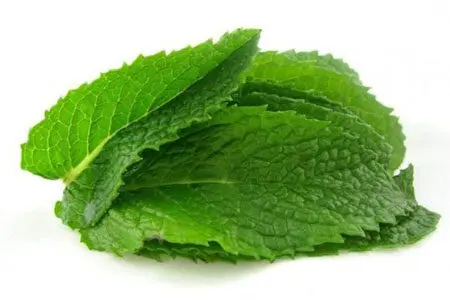
Mint helps to better concentrate on work. Moreover, the effect develops both when inhaling its vapors, and when taken orally.
One study involved 24 young adults who received peppermint capsules. As a result, they performed the best on all cognitive tests. [23].
Peppermint flavored oil has been shown to improve memory in another study (compared to other essential oils) [24].
12. It’s the perfect drink
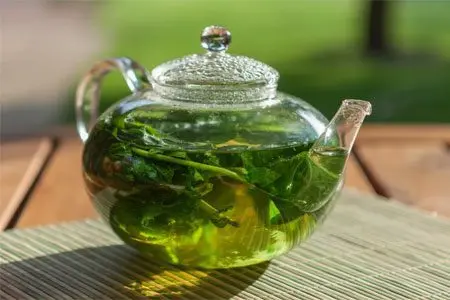
Peppermint tea has a pleasant taste, so it is easy to introduce it into the diet. You can use store-bought tea bags or loose leaf tea, or you can grow the plant yourself.
Peppermint tea recipe:
Bring 2 cups of water to a boil.
Turn off the burner and add a handful of torn mint leaves to the water.
Cover the container with a lid and leave for 5 minutes.
Strain the drink.
You can drink it at any time of the day. It is taken after meals to normalize digestion. In the evening, tea is drunk to improve the quality of sleep, and during the day – to increase concentration and get a boost of energy.
Medicinal properties of mint for women
A diverse chemical composition determines the healing properties of mint for the female body, namely:
Reducing pain during menstruation.
Removal of unpleasant symptoms of menopause.
Help in the fight against excess weight.
Reducing inflammation in the pelvic organs.
Normalization of hormonal levels.
Improving the condition of the skin and hair, improving the functioning of the sebaceous glands, increasing the tone of the dermis.
Can pregnant women drink mint?

Mint is not forbidden to pregnant women, but it is necessary to drink drinks based on it with caution and in small quantities. Exceeding the dosage can lead to increased uterine contractions and cause miscarriage or premature birth. The restriction is due to the estrogens contained in the plant.
In the normal course of pregnancy, mint can bring undoubted benefits to the body of the expectant mother. Peppermint tea can eliminate the symptoms of toxicosis, get rid of headaches, relieve nervous tension, normalize sleep, and reduce swelling. Useful drink for women with flatulence and constipation.
Contraindications to taking mint during pregnancy:
low blood pressure;
Varicose veins;
Mint allergy.
Pregnant women should not take more than 1-2 glasses of a weak infusion of mint per day. If a woman has doubts, it is better to consult a doctor.
Can lactating women mint?
Breastfeeding women can drink mint tea. Most often, they begin to add it to the drink at 3-4 months of pregnancy, but if everything is in order with the health of the mother and baby, then its use is permissible from the first month after childbirth.
It is believed that mint in small quantities helps to improve lactation. Its reception allows you to normalize the process of digestion of food, relieves flatulence. This property is useful not only for a nursing mother, but for a child suffering from colic.
Mint should be consumed in moderation and only after pre-treatment. To reduce the content of essential oils and menthol in fresh leaves, you need to scald them 2-3 times with boiling water, then rinse with cold water. Only after that they can be brewed and drunk in the form of tea. A breastfeeding woman should not take more than one glass a day.
Mint for oily skin

Mint normalizes the production of sebum, so it can be used to improve the condition of the dermis. To achieve the optimal effect, they drink it in the form of an infusion, and also make masks with it.
Mask recipe for oily and combination skin:
Crush 10 fresh mint leaves.
Grate half of the cucumber with the skin on it.
Mix the ingredients and add 1 tbsp. l. lemon juice.
The mixture is spread on the face for 20 minutes, after which it is washed off with warm water.
The procedure is completed by applying a cream suitable for oily skin care.
You can drink mint infusion in its pure form. To improve the taste and increase the benefits of the drink, add 1 teaspoon of honey to it.
The benefits of mint for men
Mint tea is especially beneficial for men. It is enough to drink 1-2 glasses a day to get the following effects:
Increase the body’s resistance to stress.
Normalize the work of the reproductive system.
Relieve anxiety and tension.
Increase libido.
Improve sleep quality.
For men engaged in heavy physical labor, mint is especially useful, as it allows you to relax after working days, as well as reduce pain in the lower back, joints and muscles.
Types of mint, with photos and names
In total, more than 25 species and over ten hybrids of mint can be found in the world. The uniqueness of this plant is that different species can have completely different amounts of metabolites. It is from this that each type of mint has a different smell, and essential oils from mint, depending on the type, may differ.
The most famous and popular type of mint is peppermint (Mentha piperita). This species can be grown both in your garden and on an industrial scale. She is unpretentious in care and weather conditions.
By the way, peppermint is a hybrid between spearmint and water mint (Mentha spicata and mentha aquatica, respectively).
Types of mint are distinguished not only by smell, but also by appearance. For example, the leaves of pennyroyal mint reach a length of only 1 centimeter, but the long-leaved or forest mint (Mentha longifolia) can surprise you with leaves that reach 15 centimeters in length.
Each species can be identified and marked with features that distinguish them from each other.
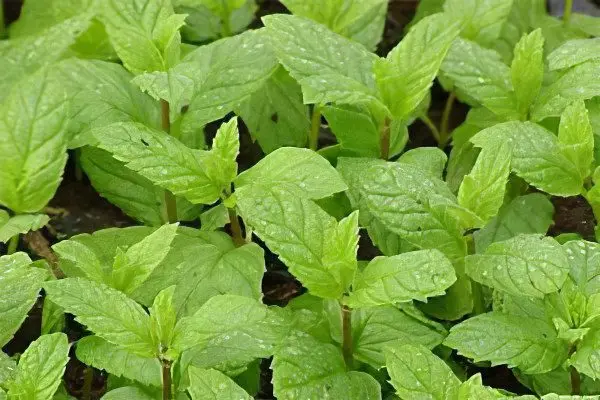 English green mint This mint has smooth and curly leaves with an elongated shape. Bright and juicy green color sometimes differs in dark shades. All veins can be clearly seen with the naked eye. In English it is called “spearmint”, and in German “Waldminze”. This mint is most often used to prepare jellies and various sauces. It is an excellent seasoning for pea dishes, vegetable stews, minced meat or lamb. Chefs love this mint and actively use it in cooking when cooking meat or in the confectionery industry. |
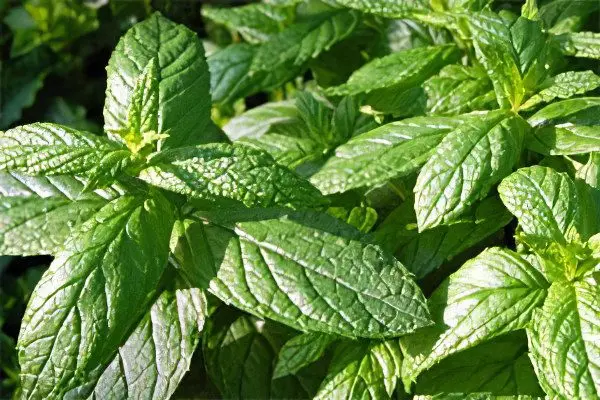 Greek mint Mentha species Dionysos or in simple terms, Greek mint has a rather pleasant and fresh aroma. Bright green smooth leaves have a serrated edge. The vein can be seen with the naked eye in the light. The plant is 0,3 to 0,8 meters long and has bright purple flowers. This mint is often added to yoghurts or sauces, it goes well with garlic. Yoghurt sauce with this mint goes well with a meat dish or vegetable salad, which is typical for Greek cuisine. |
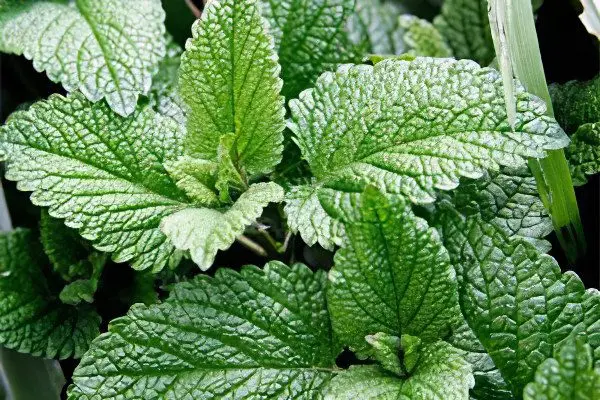 English peppermint This mint is the most diverse type of mint with a long history. The stems of the plant have a bright red hue, and the leaves themselves are dark green. The leaves are smooth, on short petioles. By itself, mint has a spicy “pungent” taste, which is why it is often used as a flavoring for drinks. With English peppermint, delicious and harmonious teas are obtained, which are good for calming the nervous system. It is also great for desserts and salads and is often used as a spice for meat or vegetable soup. |
 Peppermint “Nana” By smell, this mint resembles cumin seeds, the flowers themselves have a purple tone, and the plant reaches a length of up to half a meter. Compared to all other species, Nana pepper has light leaves. Tea with this mint is quite fragrant and soothing. |
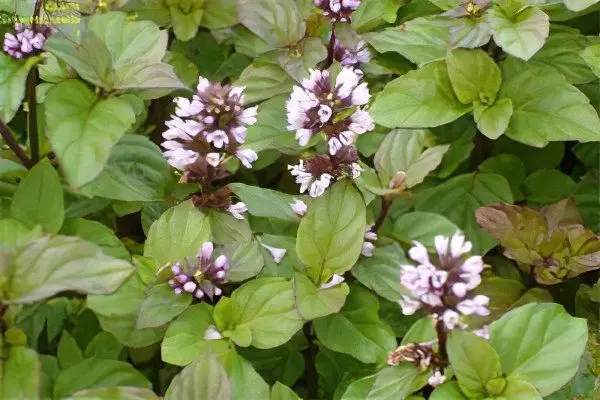 orange mint As you already understood by the name, this species has a pronounced citrus aroma. In addition, it has a lower menthol content than other types. It has a pronounced citrus taste, as it is a hybrid. The leaves have a rounded shape and a bright light green color, which in the light is distinguished by a red tint. Such mint is used for fruit cocktails or as a dessert garnish. |
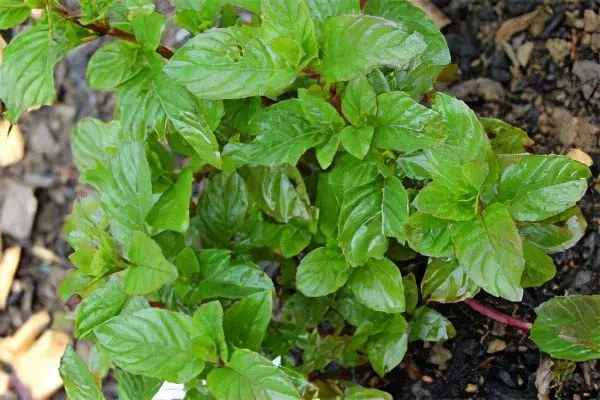 lemon mint Another hybrid with citrus fruits, it has a sour smell of lemon and, like orange, is used to make desserts and cocktails. Pleasant lemon sourness can also be used to give tea an unusual flavor. |
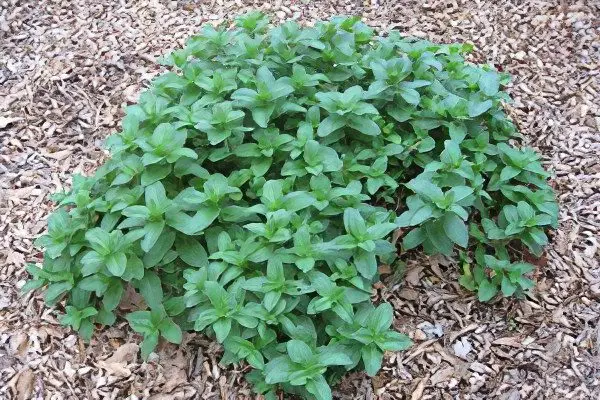 Spearmint This mint in appearance is similar to peppermint, however, it has a bright and non-standard taste like chewing gum with menthol. By the way, this is one of the types of mint that tolerates cold weather well. This mint is rich in menthol. |
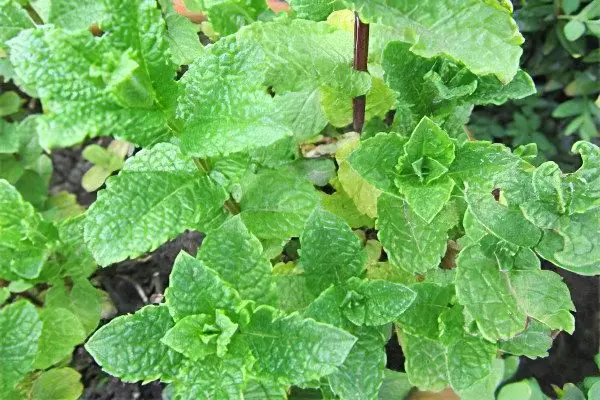 Moroccan mint If you have heard of Moroccan refreshing tea, then you have heard of mint, which is used to make it. It has a rather sweet smell and a pleasant refreshing note. Moroccan mint is used to make desserts and meat sauces. The leaves of this mint have a light green tint, oval shape, which is pointed at the top. Drinks with this mint are sweet and refreshing, but do not have a strong mint flavor. |
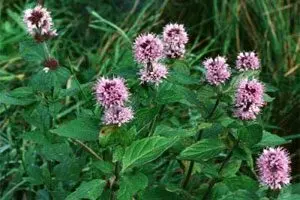 water mint This is a wild mint that grows in forests and fields. The leaves of this mint are oval in shape and have serrated edges. |
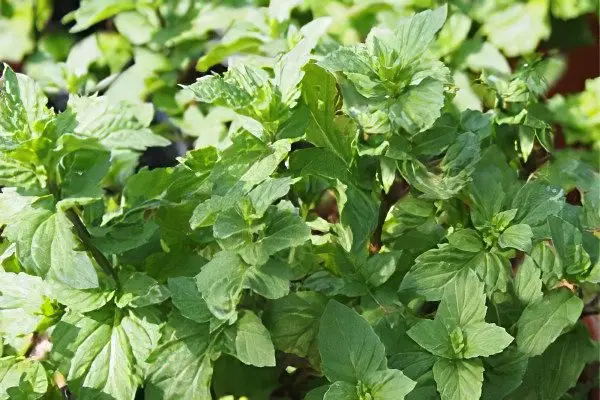 curly mint Curly mint has wavy leaves with a rich green color. It grows in large numbers and looks more like thistle than mint. Its smell is something between cumin and camphor. That is why curly mint is chosen as a seasoning for a meat dish or vegetable salad. Its pleasant and tart taste will emphasize the meat note. |
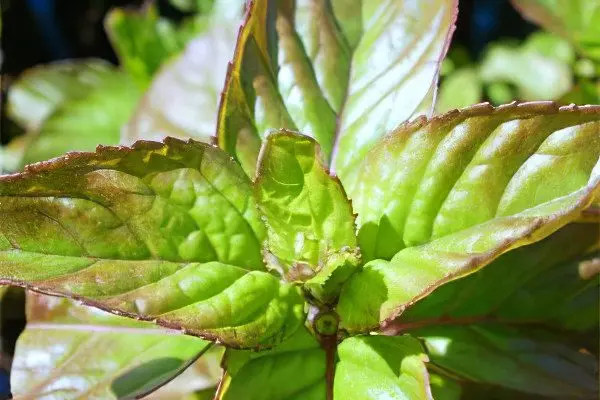 basil mint This mint has a spicy smell, which is why it is often used in the preparation of vegetable salads. Basil mint flowers are bright purple, and its leaves and stem have a reddish hue. This mint goes well with salads that contain tomatoes. |
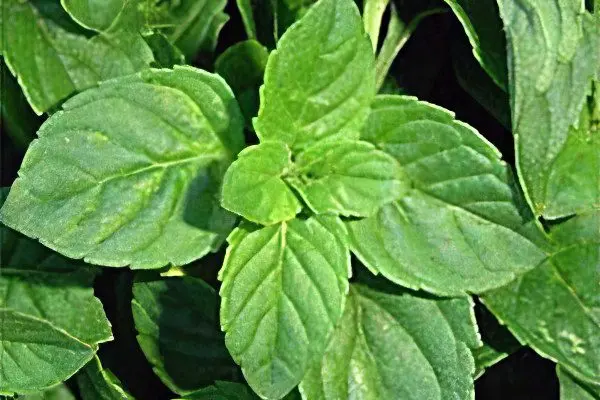 Mint “Mentuccia” The leaves of this mint are small in size and have a round shape. Mint itself grows in Italy. The appearance is distinguished by bright purple flowers. “Mentuccia” is used for bean or vegetable dishes, as well as during the preparation of various salads. The aroma of this mint can be compared to the smell of cumin. Italians often use this mint in their dishes. |
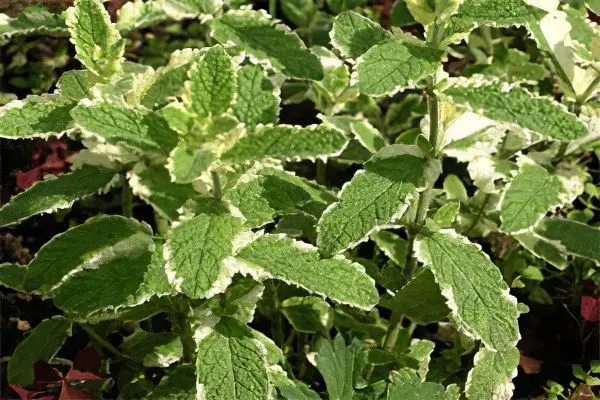 pineapple mint The leaves of this mint are lowered down and have a white frame around the edges. The plant itself is rather short in stature with white or pale pink flowers. The leaves have a pronounced tart taste, but despite the name, they are not at all like pineapple. This mint is well used for salad dressings or in the preparation of drinks. The two-tone color allows it to be used to decorate dishes. |
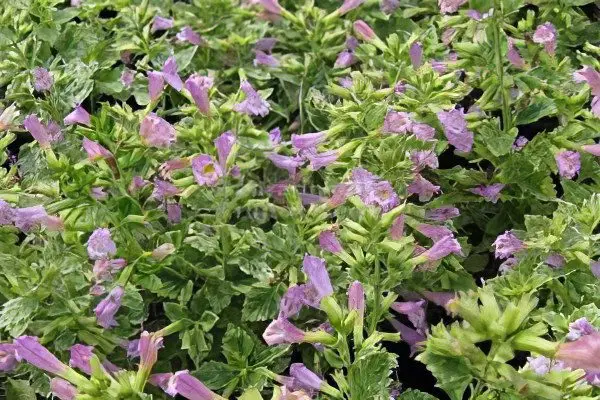 mountain mint Calamintha officinalis has bright purple flowers and black edges on the stem. The human eye will be able to see clear veins on the leaves. The taste is an amazing combination of camphor notes and a standard mint aroma. Beautiful lilac flowers are used to decorate desserts, and mint is added to tea and drinks. |
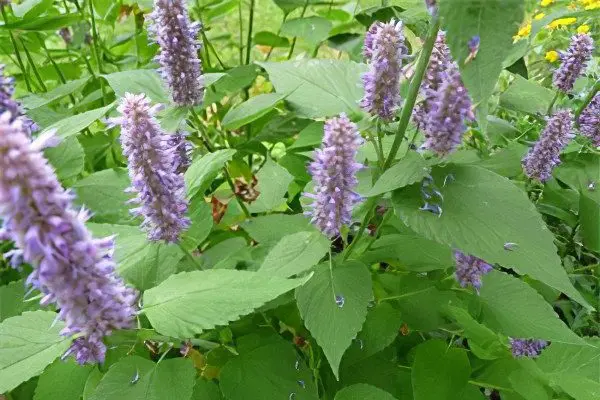 Korean mint Grown Agastache rugosa in North Asian regions, mint has delicate and pleasant leaves, and its flowers are bright purple. Outwardly, it resembles hyssop to many, but with a bright and fresh aroma. The leaves of this mint have a rich menthol flavor. |
What diseases are mint used for?
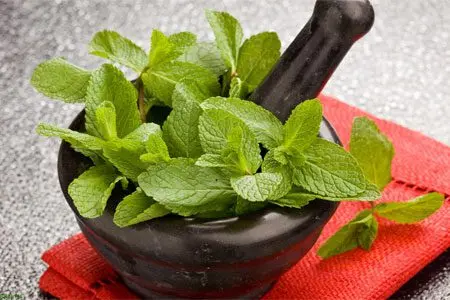
Mint is rich in menthol (contained in the leaves of the plant), which has local anesthetic, antispasmodic and antiseptic properties, promotes reflex expansion of the coronary vessels. For angina pectoris or pain in the stomach and intestines, mint is used orally. For neuralgia, toothache, or as an antiseptic and analgesic for respiratory diseases with bronchitis and bronchiectasis, mint is used externally.
For the treatment of migraine, menthol is used in a mixture with paraffin in the form of pencils. Also, menthol is part of Zelenin drops, valocordin, drops and ointments for the treatment of the common cold. Peppermint oil is also used for inhalation. Peppermint oil is included in the composition of mint drops and tablets. Mint water is added to improve the taste of potions and to rinse the mouth. For the treatment of neurodermatitis, menthol alcohol is used. To improve digestion, increase appetite, to get rid of nausea and vomiting, infusions and tinctures from mint leaves are used.
But mint is used not only in our country, for example, in Bulgaria it is used to treat diseases of the stomach (with spasms) and intestines, with flatulence, diarrhea, nausea and vomiting, as well as a choleretic agent, with gallstones and jaundice , as an analgesic for hepatic colic, stimulating cardiac activity and relieving headaches.
Mint leaves have also been used in Germany. There they are used in the form of tea to get rid of diseases of the digestive tract, flatulence and improve appetite, and they also take mint baths.
Decoctions, tinctures and mint oils are prepared for the same diseases in Australia.
Mint leaves are quite common in France. There, mint is used as an antispasmodic, choleretic, wound healing agent, as well as to improve appetite and digestion.
As an analgesic, anti-inflammatory, disinfectant for diseases of the gastrointestinal tract, neuralgia, insomnia, migraine, mint leaves are used in Poland. In the same place, mint leaves are used for inflammation of the periosteum, middle ear and other diseases. In addition to all this, mint is included in fees to improve taste and smell.
Russian folk medicine uses mint leaves as a refreshing, choleretic and diaphoretic agent. From the leaves of wild mint, juice is made, which is used to treat kidney stones, and also as a diuretic, mixing a tablespoon with white wine.
Mint leaves and flowers, fresh or dried, are used to prepare various dishes as a seasoning for salads, soups, meat and vegetable dishes, and added to sauces and teas for flavor.
Tea, which includes mint, has a choleretic, diaphoretic, calming effect. Mint is part of the gastric collection and in the fees for taking baths.
Mint is widely used in the food, confectionery and perfume industries, it is contained in toothpastes and powders, etc.
To get rid of headaches, essential oil (in an alcohol solution of 1: 4) is rubbed into the skin, it is also used for migraines, skin inflammations, or for inhalation for colds.
Recipes for the use of mint in folk medicine
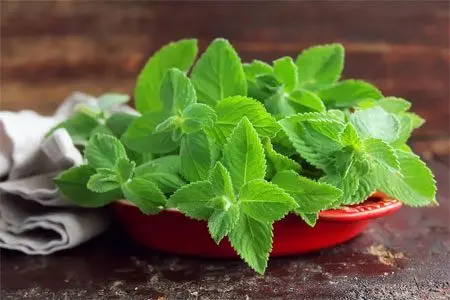
In folk medicine, mint is used as an analgesic and a powerful antiseptic. Also, many advise rinsing the mouth with mint decoction in case of toothache or sore throat. In addition, it is useful in diseases of the stomach and spasms.
Mint decoction for pregnant women. Peppermint decoction is excellent for nausea in pregnant women and weak fermentation. Steep a tablespoon of mint in two cups of boiling water and leave for 10 minutes. It can be taken orally or smeared on the skin in case of itching.
A decoction of mint for gastritis and heartburn. Mint perfectly increases appetite and helps with gastritis and heartburn. Brew 2 teaspoons of dry mint in a glass of boiling water and leave for 30 minutes, then strain. Take 60 ml before morning or evening meals.
Peppermint tea for SARS. Peppermint tea is great for colds, bronchitis and sore throats. The decoction is prepared quite simply: brew a tablespoon of mint with a small amount of boiling water, and later use it as a regular tea leaves. An additional effect can be achieved by using this tea with lemon and honey.
Tincture for migraines. 15 drops of tincture help to cope with a headache. At 70% alcohol, mint must be infused for a week. The ratio is as follows: 1 tablespoon of mint to 20 tablespoons of alcohol. Take 15 drops in a glass of water every day.
Peppermint Oil has a positive effect when inhaled, and is also used in the preparation of lotions that help get rid of fungal infections on the nails. To do this, you need to grind the leaves and stems of the plant to a gruel and pour boiling water over it. Wrap everything that turned out in a thin cloth and attach it to the affected area of u5buXNUMXbthe skin. Leave on for XNUMX minutes, then rinse and pat the area dry with a clean towel. Repeat twice a day.
With erosion of the uterus. Peppermint essential oil is used to treat uterine erosion, for this it is necessary to prepare an oil from 10% tincture of mint leaves, mix with sunflower or Provence oil and evaporate the alcohol in a water bath.
Baths with mint help you relax and relieve fatigue. For their preparation, use 50 grams of leaves per 10 liters of water.
Mint lotions help to remove circles, redness or irritation in your eyes. To do this, you will need to pour 2 tablespoons of mint into 500 ml of hot water, boil everything over low heat for 10 minutes, strain the broth and apply cotton pads soaked in the broth on the eyelids for 2 minutes. The procedure can be repeated up to 4 times a day.
By the way, mint steam baths perfectly remove red dots, reduce the amount of inflammation on the face and have a good antiseptic property.
Mint infusion
Mint infusion is prepared as follows: 2 teaspoons of mint leaves are poured into 250 ml of boiling water (daily dose), infused for an hour, and then filtered. During the day, it is recommended to drink the remedy in sips.
Essential oils of peppermint
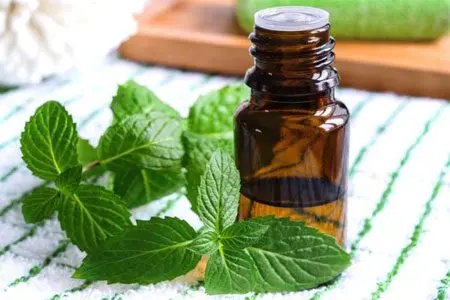
This oil is actively used in case of disruption of the nervous, respiratory, digestive or endocrine systems.
Quite an effective remedy for tachycardia, arrhythmia or hypertension. Peppermint oil is used to treat infections, stomatitis, tooth decay, or gum disease. The oil has a tonic and analgesic effect.
How to use peppermint essential oil:
Three times a day, 1 to 3 drops per dose. It is better to use with sugar or honey and drink juice, tea or sour milk drinks;
Do inhalations. For 1 procedure, 2 drops of oil per 10 ml of saline. Inhalation is done once a day;
Massage: dissolve 10 ml of mint drops in 5 ml of vegetable oil;
2-5 drops of oil in half a glass of water are used to gargle;
For aromatherapy use 6 drops of oil per 15 square meters;
7 drops per bath, for therapeutic baths;
It is worth paying attention to dosages, as excess can lead to problems with physical and mental health.
Peppermint essential oils are not recommended for children, pregnant women, allergy sufferers and nursing mothers.
How to make peppermint tincture?
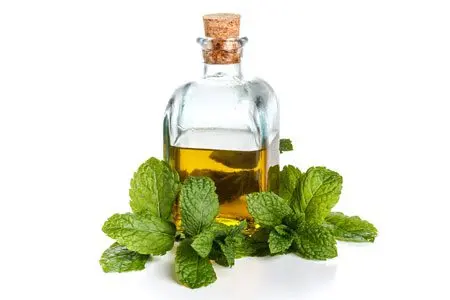
Peppermint tincture in an alcoholic solution is actively used for rinsing and inhalation, as well as for skin diseases and headaches.
Making this tincture at home is easy:
Mix 20 grams of dry leaves with vodka or 75% alcohol;
Leave in a dark place for 2,5 weeks;
The resulting liquid must be filtered and taken 15 drops once a day;
The second recipe is prepared on the basis of fresh mint:
Pour 6 sprigs of freshly picked mint with hot water and dissolve 100 grams of sugar there;
Add half a liter of vodka and leave for 2,5 weeks in a dark, cool place;
This tincture is recommended for overexcitation, sleep disturbance, hiccups or toothache. It perfectly awakens appetite and stimulates the digestive system, helps to normalize the work of the heart and is prescribed in case of gynecological diseases.
Not recommended for pregnant or lactating women, hypertensive patients and men who suffer from low potency and children under 12 years of age.
How to take peppermint tincture?
Peppermint tincture helps to normalize the work of the nervous system, calm down, relieve irritability. It is used to treat the gallbladder, to get rid of muscle spasms, headaches. It relieves inflammation, helps to cope with nausea.
Take pharmacy tincture of peppermint in the amount of 10-15 drops. They are dissolved in 2 tablespoons of water and drunk 30 minutes before meals. Multiplicity of reception – 3 times a day.
Homemade alcohol tincture is taken in 30 drops. It should not be offered to children under 12 years of age.
Peppermint tincture for hair growth
You can speed up hair growth with peppermint tincture. To quickly grow the length, it is applied in the form of a mask.
Mode of application:
Mix 2 tsp. honey, 1 tsp cream, 1/2 tsp. tinctures, 1/2 tsp. olive oil.
Apply the resulting composition to dry or damp hair roots, spread the residue along the entire length.
Cover the head with plastic wrap, wrap with a towel and leave to act for 30 minutes.
Wash your hair with shampoo.
The mask is used once a week for 1 months.
Mint for weight loss
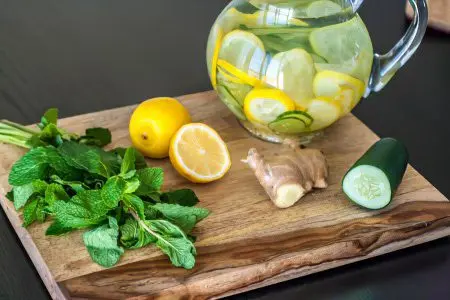
Nutritionists actively use mint in the preparation of diets designed to get rid of excess weight.
Mint helps to lose weight, as it has the following properties:
Activates metabolic processes, accelerates metabolism.
Increases intestinal motility, so that food is digested faster.
Neutralizes the processes of fermentation and putrefaction in the digestive tract.
Stimulates the flow of bile.
Takes part in lipolysis (the process of splitting fats).
Helps to get rid of constipation, as it has a mild laxative effect.
Reduces cortisol levels, which hinder weight loss.
The calorie content of the leaves is minimal. 100 g of fresh mint contains only 49 kcal. Peppermint tea can be drunk before exercise to increase its effectiveness. However, it should not be consumed before meals, as it stimulates the appetite.
It is useful to drink water with lemon and mint. The drink is prepared at night by pouring 5 mint leaves into 0,5 liters of water. After breakfast, divide the volume into 2 servings, add a little lemon juice and drink a glass in the morning and evening.
Drink from cucumber, lemon, ginger and mint for weight loss
This drink is also known as Sassi water, which forms the basis of the American Dietetic Association’s Flat Stomach Diet.
Recipe:
Lemon with zest is cut into rings, a fresh cucumber with skin is cut in a similar way.
Grind 20 g of ginger on a grater.
Cut 15 mint leaves.
All components are mixed and crushed with a mortar so that they let the juice flow.
Pour the mixture with 2 liters of non-carbonated mineral water, close the lid and put it in the refrigerator overnight.
The resulting drink should be drunk over the next day.
How to brew mint?
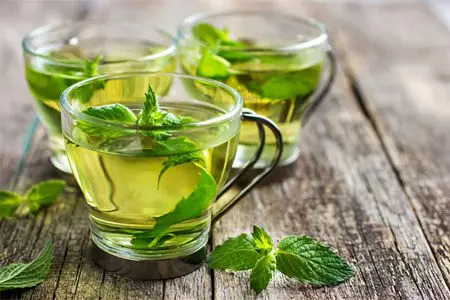
In order for mint to bring maximum benefit, it must be brewed correctly. Features of the preparation of infusion from dried raw materials:
Place 1 tablespoon of dried herbs in a teapot.
Pour it with 250 ml of hot, but not boiling water.
Leave to infuse under a closed lid for 20 minutes.
Strain the drink and add 1 more glass of warm water to it.
Such a composition can be drunk in its pure form. It is especially useful before bedtime, as it has a sedative effect. During the day, it can be added to black or green tea.
Fresh mint recipe:
The teapot for brewing should be rinsed with boiling water so that the mint leaves reveal their aroma and give the drink maximum benefit.
The washed leaves are put in a teapot in the amount of 5-8 pieces.
Pour raw materials with hot water.
Leave to infuse for 5 minutes.
Peppermint tea made from fresh leaves is especially beneficial immediately after brewing. Such a drink goes well with green and black tea, if diluted in equal proportions.
Recipes for making desserts and lemonades with mint
For making lemonades and desserts, it is not at all necessary to look for fresh mint. Even when dried, it retains its aroma and shares its flavor with foods. Dried mint lasts longer and takes up less space.
Lime mint mojito recipe
To make Mojito with Lime and Mint, you will need the following ingredients:
Limes – 2 pcs.
Mint – 0,2 kg.
Sugar – 50
The plant is washed, the leaves are separated from the branches. The limes are cut into 4 pieces. The leaves are placed in a mortar, sprinkled with sugar and crushed with a wooden pestle. Transfer the mixture to a suitable container, add the lime sliced u1buXNUMXbinto slices. Pour the mixture with mineral or plain water in the amount of XNUMX liter. The drink is served cold.
Video: Mojito cocktail, very simple and tasty (non-alcoholic).









